The AMD Ryzen 9 7950X3D Review: AMD's Fastest Gaming Processor
by Gavin Bonshor on February 27, 2023 9:00 AM ESTCPU Benchmark Performance: Power And Office
Our previous sets of ‘office’ benchmarks have often been a mix of science and synthetics, so this time we wanted to keep our office section purely on real-world performance. We've also incorporated our power testing into this section too.
The biggest update to our Office-focused tests for 2023 and beyond include UL's Procyon software, which is the successor to PCMark. Procyon benchmarks office performance using Microsoft Office applications, as well as Adobe's Photoshop/Lightroom photo editing software, and Adobe Premier Pro's video editing capabilities. Due to issues with UL Procyon and the video editing test, we haven't been able to properly run these, but once we identify a fix with UL, we will re-test each chip.
We are using DDR5 memory on the Ryzen 9 7950X3D and the other Ryzen 7000 series we've tested. This also includes Intel's 13th and 12th Gen processors. We tested the aforementioned platforms with the following settings:
- DDR5-5600B CL46 - Intel 13th Gen
- DDR5-5200 CL44 - Ryzen 7000
- DDR5-4800 (B) CL40 - Intel 12th Gen
All other CPUs such as Ryzen 5000 and 3000 were tested at the relevant JEDEC settings as per the processor's individual memory support with DDR4.
Power
The nature of reporting processor power consumption has become, in part, a bit of a nightmare. Historically the peak power consumption of a processor, as purchased, is given by its Thermal Design Power (TDP, or PL1). For many markets, such as embedded processors, that value of TDP still signifies the peak power consumption. For the processors we test at AnandTech, either desktop, notebook, or enterprise, this is not always the case.
Modern high-performance processors implement a feature called Turbo. This allows, usually for a limited time, a processor to go beyond its rated frequency. Exactly how far the processor goes depends on a few factors, such as the Turbo Power Limit (PL2), whether the peak frequency is hard coded, the thermals, and the power delivery. Turbo can sometimes be very aggressive, allowing power values 2.5x above the rated TDP.
AMD and Intel have different definitions for TDP that are, broadly speaking, applied the same. The difference comes from turbo modes, turbo limits, turbo budgets, and how the processors manage that power balance. These topics are 10000-12000 word articles in their own right, and we’ve got a few articles worth reading on the topic.
- Why Intel Processors Draw More Power Than Expected: TDP and Turbo Explained
- Talking TDP, Turbo and Overclocking: An Interview with Intel Fellow Guy Therien
- Reaching for Turbo: Aligning Perception with AMD’s Frequency Metrics
- Intel’s TDP Shenanigans Hurts Everyone
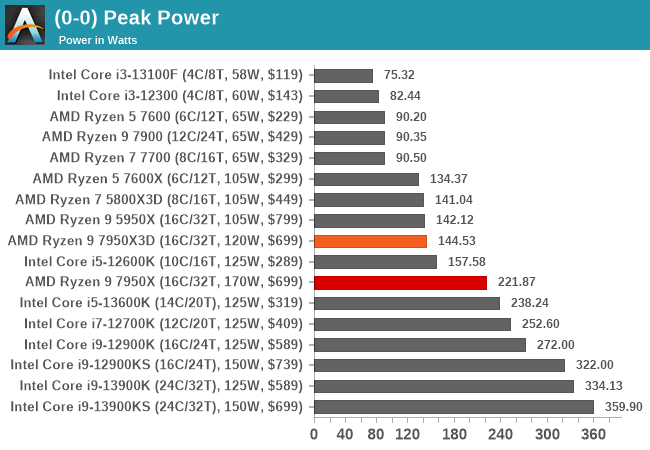
Given that the Ryzen 9 7950X3D has a lower TDP and PPT rating than the Ryzen 9 7950X, it pulls less power. We observed a peak power output of 144.53 W on the 7950X3D, compared to 221.87 W on the 7950X. Talking figures, the Ryzen 7950X3D is pulling around 65% of the power of the 7950X, which is understandable given the power limitations due to the CCX laden with AMD's 3D V-Cache packaging.
Looking at the power consumption of the Ryzen 9 7950X3D in closer detail, we can see that it delivered a consistent load of between 140 and 144 W in our Prime95 sustained power test. This is around 18 Watts lower than the official Package Power Tracking (PPT) level AMD has set at 162 W. However, it operates higher than the TDP of 120 W, which is to be expected. The TDP and PPT ratings are different as the TDP is the base power the CPU should be drawing, while the PPT (socket), set at 162 W, is the maximum the processor can draw as a maximum under full load.
Office/Web
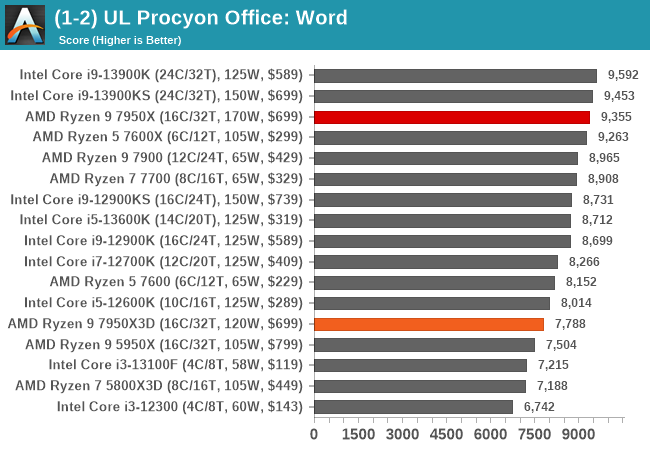
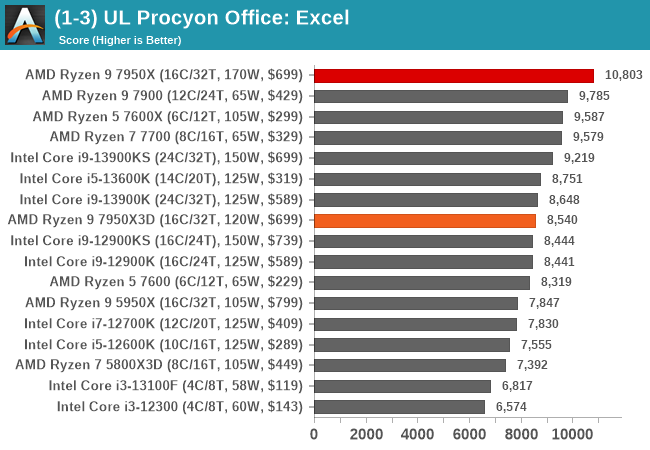
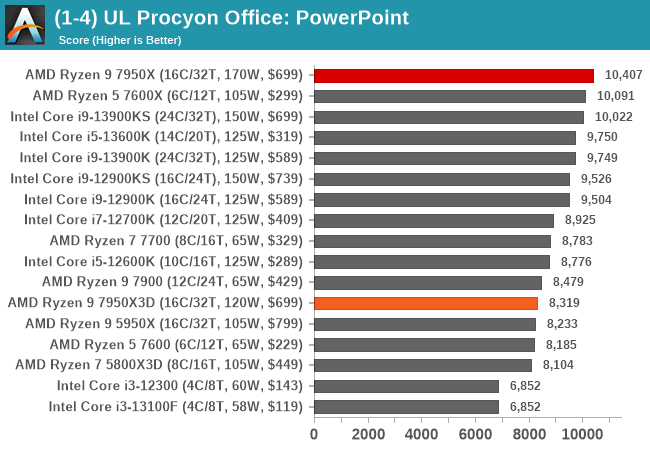
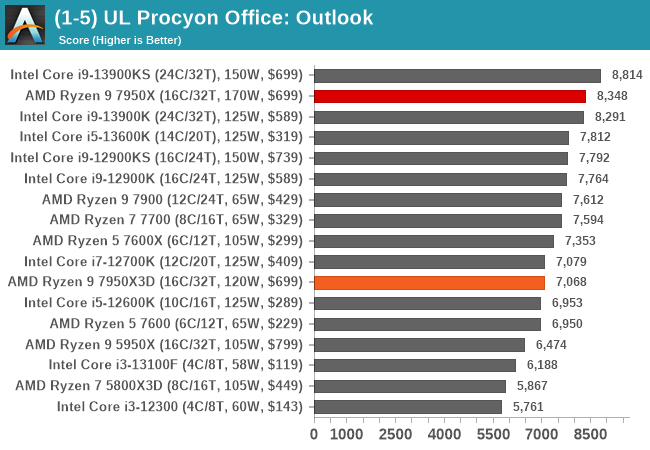
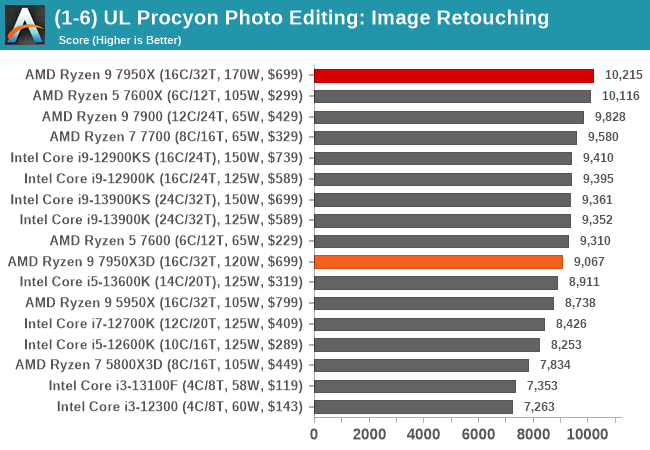
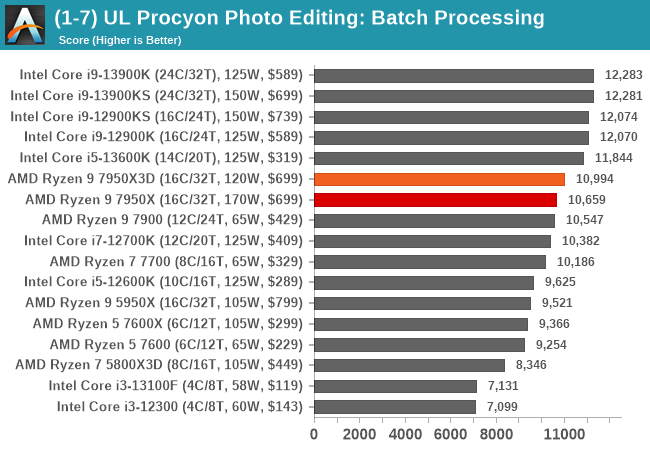
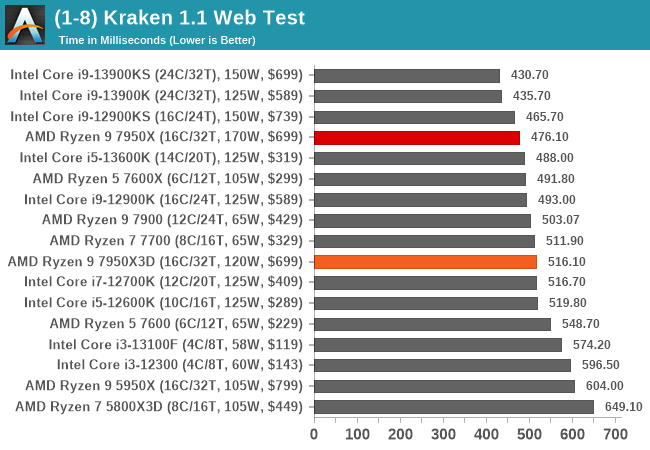
In our office-based testing, the Ryzen 9 7950X3D performs a little worse than the 7950X, but this is to be expected given the differences in TDP, PPT, and the overall power envelope. Still, the 7950X3D performs well and is more than suitable for office and web-based tasks.


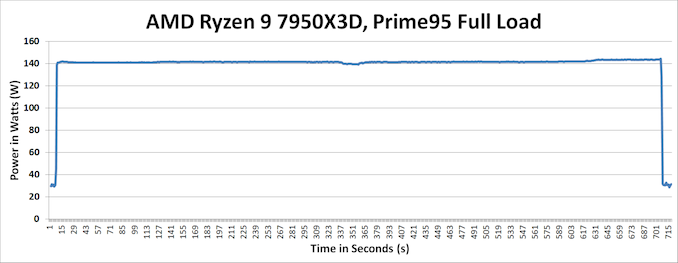








122 Comments
View All Comments
AvidGamer - Monday, February 27, 2023 - link
Fully agree with the content and all arguments made in the above comment. Very good points! I too would have preferred a fully functional product instead of such an IMHO half assed approach which after all is said and done excels at basically nothing compared to all the other already existing good options from Intel and AMD. Shame on you AMD for what you have done there! IMHO that's just disgusting! I can't believe I've waited months for something like this, never again, urghhh...Gastec - Wednesday, March 1, 2023 - link
I've waited years to upgrade my i7-860, PCIe 2.0 system. I'm still waiting, now for the Ryzen 7900X3D to pop out. I'm pretty sure some other bad things will happen till then, that will prevent me to "upgrade". Hopefully a nuke.Tom Sunday - Monday, March 20, 2023 - link
Yes I am sure as well that some other not so good things will happen preventing me to "upgrade." Not withstanding our seemingly never-ending financial and inflationary conditions. The 7950X3D only excelling in gaming but not in content creation is disappointing to say the least. Many actually make money with content creation to pay for their casual gaming luxuries. For the 7950X3D a MSRP of USD$699 is an expensive trip for just gaming. Especially since the greater majority of gamers are no exactly living in the higher-end of the food chain nor are they the primary bread-winner for their family. What was AMD thinking? The only good news is that AMD usually starts dropping their intro-prices on all of their products virtually within a few months. So for me now sitting pretty and free in Mom’s basement, there may be hope after all and for now keeping on playing 'Wolfenstein' in all of its glory and a train ride to Berlin!Jp7188 - Wednesday, March 8, 2023 - link
3D V cache and 5.7+GHz across all cores would have been ideal, but it seems apparent it was not possible to achieve in this generation. Given the choice was cache or speed I think AMD did the best they could.Dribble - Thursday, March 2, 2023 - link
These cpu's won't be popular enough to get it fixed, chances are it will always be a mess.Papaspud - Monday, February 27, 2023 - link
Looks to me like any good processor from the last 1-2 years will do just fine. The gains are getting smaller, generational wise.meacupla - Tuesday, February 28, 2023 - link
Yes and no.If you play a lot of simulation games, particularly games like: factorio, Timberborn, Infraspace, Transport Fever 2, etc. and to a lesser degree Civ6, and Total War, those games will benefit substantially when the game asks the CPU to do all the pathfinding calculations.
For those games, it's easy to have 120fps at the start of the game, but as soon as the game has thousands of units asking for pathfinding at the same time, you will quickly find yourself with 100% CPU usage, 10% GPU usage, and <15fps.
These games benefit greatly from that massive cache on X3D.
Gastec - Wednesday, March 1, 2023 - link
Or in other words wait until someone else tests the CPU with the video games you want to play, before buying it. Wait, wait, wait. Work, work, work.cruiseliu - Monday, February 27, 2023 - link
7950X3D falls behind 7950X in simulation tests, while 5800X3D outperforms 7950X. That is strange.Could you please clarify which CCD is used in these tests?
Gavin Bonshor - Monday, February 27, 2023 - link
I'm looking into it. I'm testing in all three modes in our compute tests to see where AMD's PPM and 3D V-Cache driver gets it right and where it gets it wrong (if at all).